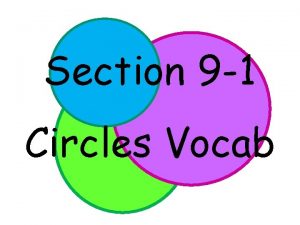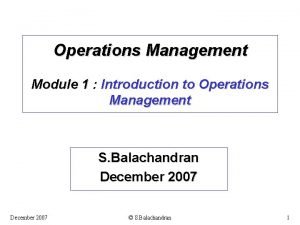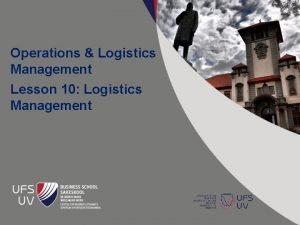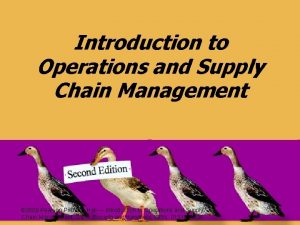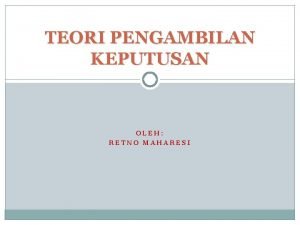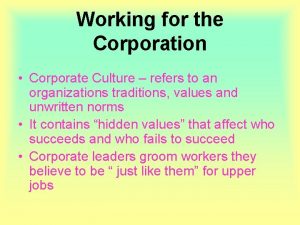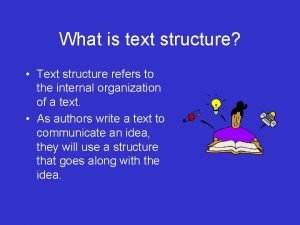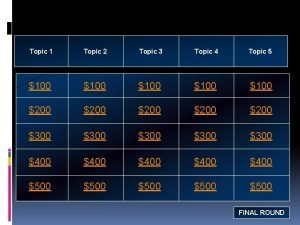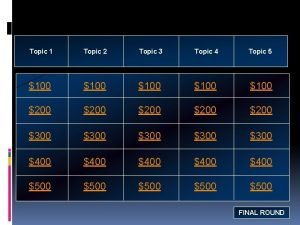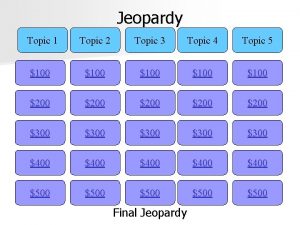Operations Topic 1 Introduction to Operations Operations refers


![The language of operations � 1] Inputs – ◦ tangible elements such as the The language of operations � 1] Inputs – ◦ tangible elements such as the](https://slidetodoc.com/presentation_image_h2/de46147e2ad46022fdce282223f1efa5/image-3.jpg)





![OPTION 1] Cost Leadership approach - General Minimisation of all costs: the aim is OPTION 1] Cost Leadership approach - General Minimisation of all costs: the aim is](https://slidetodoc.com/presentation_image_h2/de46147e2ad46022fdce282223f1efa5/image-9.jpg)

![Option 2] Product Differentiation Approach (How can we be different to our competitors? ) Option 2] Product Differentiation Approach (How can we be different to our competitors? )](https://slidetodoc.com/presentation_image_h2/de46147e2ad46022fdce282223f1efa5/image-11.jpg)


- Slides: 13

Operations Topic 1

Introduction to Operations � Operations refers to the business processes that are involved in the transformation or production of a good or service. � It involves taking inputs and adding value to them so that consumers are willing to pay a premium for the output. � http: //www. youtube. com/watch? v=M 6 v. Bo_u. TGl. Y � http: //www. youtube. com/watch? v=EM 5 BTbr. Jh_k
![The language of operations 1 Inputs tangible elements such as the The language of operations � 1] Inputs – ◦ tangible elements such as the](https://slidetodoc.com/presentation_image_h2/de46147e2ad46022fdce282223f1efa5/image-3.jpg)
The language of operations � 1] Inputs – ◦ tangible elements such as the raw materials, land, labour, finance as well as intangible things such as ideas and creativity that are used in the transformation process. � 2] Transformation – the conversion of inputs into outputs � 3] Outputs – the finished good or service ready for sale.

The key concept of “interdependence” Operations Marketing Operations Human Resources Marketing Finance Each and every function depends on each other Marketing Finance Human Resources Operations Finance

Operations in a goods business

Operations in a service business

The strategic role of operations Cost Leadership Product Differentiation

TWO ways to approach a market Cost Leadership approach Differentiation approach involves aiming to have the lowest costs or to be the most price competitive in the market. Involves distinguishing products from your competitors in some ways Aim: to run the lowest cost and most efficient operations department. Aim: To focus on producing quality products that are different from those on the market already. Reason: This will allow me to produce products at a cheaper cost than my competitors. Reason: Consumers will recognise these differences and be prepared to pay higher prices for them. Result: I will be able to sell products at an identical price in store but the profit margin will be greater for me than them. Result: focusing on quality and tailored production allows me to build strong customer loyalty and charge higher prices than competitors.
![OPTION 1 Cost Leadership approach General Minimisation of all costs the aim is OPTION 1] Cost Leadership approach - General Minimisation of all costs: the aim is](https://slidetodoc.com/presentation_image_h2/de46147e2ad46022fdce282223f1efa5/image-9.jpg)
OPTION 1] Cost Leadership approach - General Minimisation of all costs: the aim is to be able to sell goods on the market at the lowest possible cost. This means the manager will look for cost efficiencies in all aspects of the operations function. - Economies of scale Cost advantages that can be created as a result of an increased size of factory. Typically the cost savings come from lower purchasing costs as bargaining power with suppliers improves.

Why economies of scale happen � Larger production allows firms to buy inputs in bulk and drive down the price of these items due to their significant bargaining power. � Larger production levels justify investment in technology that will allow for specialisation in production and lead to cheaper and faster production.
![Option 2 Product Differentiation Approach How can we be different to our competitors Option 2] Product Differentiation Approach (How can we be different to our competitors? )](https://slidetodoc.com/presentation_image_h2/de46147e2ad46022fdce282223f1efa5/image-11.jpg)
Option 2] Product Differentiation Approach (How can we be different to our competitors? ) 1) Varying product features – does your product provide superior features to your competitors. A decision to increase features offered with a product will increase the cost of production. (E. g. Multi-function printer). Mac Vs Pc http: //www. youtube. com/watch? v=C 5 z 0 Ia 5 j. Dt 4 2) Varying product quality – producing products of superior quality to distinguish yourself from the competition. Telstra 4 G Network http: //www. youtube. com/watch? v=2 Fy. Zky. SXRN 4

Implications for the operations function Cost Leadership approach Differentiation Approach -Highly efficient, lowest cost methods of production. - Customised and complexity in operations as the production line must consider multi different product features. - Highly standardised production. Not inclined to produce customised products. - Use of economies of scale to reduce average per unit cost of production. Buying in bulk to reduce purchase costs. - flexible and tailored production to the needs of the client (more expensive production costs).

Questions from text �P 14 � Q, 5, 6, 7, 8, 9, 10
 Painted paragraph strategy
Painted paragraph strategy Narrow down topic
Narrow down topic Section 1 topic 8 operations with polynomials
Section 1 topic 8 operations with polynomials Circle vocab geometry
Circle vocab geometry Operations management modules
Operations management modules Introduction to operations and supply chain management
Introduction to operations and supply chain management Operation manager function
Operation manager function Introduction to operations and supply chain management
Introduction to operations and supply chain management Contoh kriteria laplace
Contoh kriteria laplace Introduction paragraph format
Introduction paragraph format Diversity refers to
Diversity refers to Corporate culture refers to
Corporate culture refers to Operating cycle formula
Operating cycle formula Structure refers to
Structure refers to



